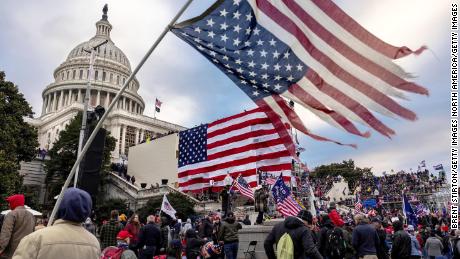(CNN)One in 10 people charged in the US Capitol insurrection are veterans or current servicemembers, according to a CNN review of court documents and Pentagon records.
At least 45 of the approximately 450 overall defendants have ties to the US military, according to the CNN review. The bulk of these 45 defendants are veterans, but a handful are still serving, including an active duty Marine Corps officer from Virginia who was arrested earlier this month.
A quarter of the defendants with military ties are also connected to right-wing extremist groups, like the Oath Keepers and Proud Boys. These groups had a big presence at the January 6 riot, and they've attracted significant attention from federal prosecutors investigating the attack and from Pentagon officials who are coming to grips with the problem of extremism in the military.
This is perhaps the most comprehensive analysis to date of the outsized role that veterans played in the insurrection. They represent 10% of all defendants charged in the riot, but only make up about 6% of the US adult population, according to government statistics from recent years.
Many of these veterans believed the conspiracy theories about the 2020 election, according to court documents. Some also said they felt a sense of patriotic responsibility, given their past military service, to stop Congress from certifying what they thought was a stolen election.
Decades of military service
Most of the servicemembers face misdemeanor trespassing offenses. But some are accused of assaulting police officers, destruction of government property, civil disorder, and conspiracy.
Michael Lopatic, who served in the Marine Corps in the 1980s, is charged in the grisly attack against a police officer who was dragged down the Capitol steps. Federico Klein, a Trump State Department official who was deployed to Iraq, is accused of using a riot shield to pummel officers. Dominic Pezzola, a former Marine corporal, was caught on tape smashing a Capitol window.
All three men have pleaded not guilty and are contesting the charges.
The 45 servicemembers were in the Army, Marine Corps, Navy and Air Force, or were in the reserves. One was part of the Army Special Forces unit known as the Green Berets. They hail from 22 states from all across the country, including Texas, Pennsylvania, Hawaii and Idaho.
They represent a true cross-section of the US Armed Forces. Some were commissioned officers, like a lieutenant colonel and a lieutenant commander, while others were enlisted troops. Some were highly decorated combat veterans, while others were kicked out for misconduct.
These veterans served in all of America's major wars in the last 60 years, including the Vietnam War, the Persian Gulf War, the Afghanistan War and the Iraq War. The combined years of service for all 45 defendants is more than 325 years.
Links to extremist groups
The CNN review found significant overlap between veterans and extremist groups. Some of these anti-government groups specifically recruit veterans because of their weapons training.
There are approximately a half dozen veterans with ties to the Proud Boys and about another half dozen with ties to the Oath Keepers, according to CNN's review of court documents.
For example, there's Joseph Biggs, the Proud Boys leader and retired Army staff sergeant who served in Iraq and Afghanistan. There's also Jessica Watkins, a retired Army private who was in an infantry unit in Afghanistan, and the alleged ringleader of the Oath Keepers conspiracy case.
Both are separately accused of planning for violence on January 6. They've pleaded not guilty.
This overlap of veterans and extremist groups has put a spotlight on the Pentagon's efforts to crack down on extremism in its ranks, which officials say is a top priority. Defense Secretary Lloyd Austin has launched new initiatives to deal with the issue, like updating the definition of "extremism" and warning outgoing members of the dangers posed by these right-wing groups.




